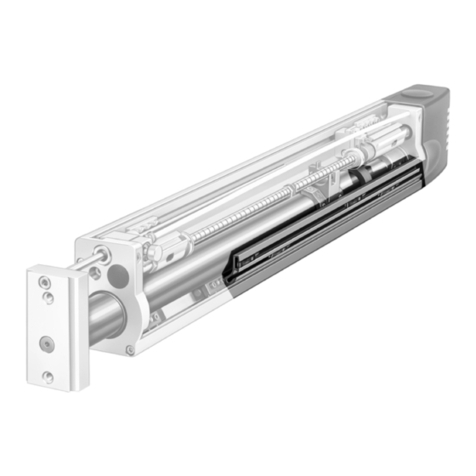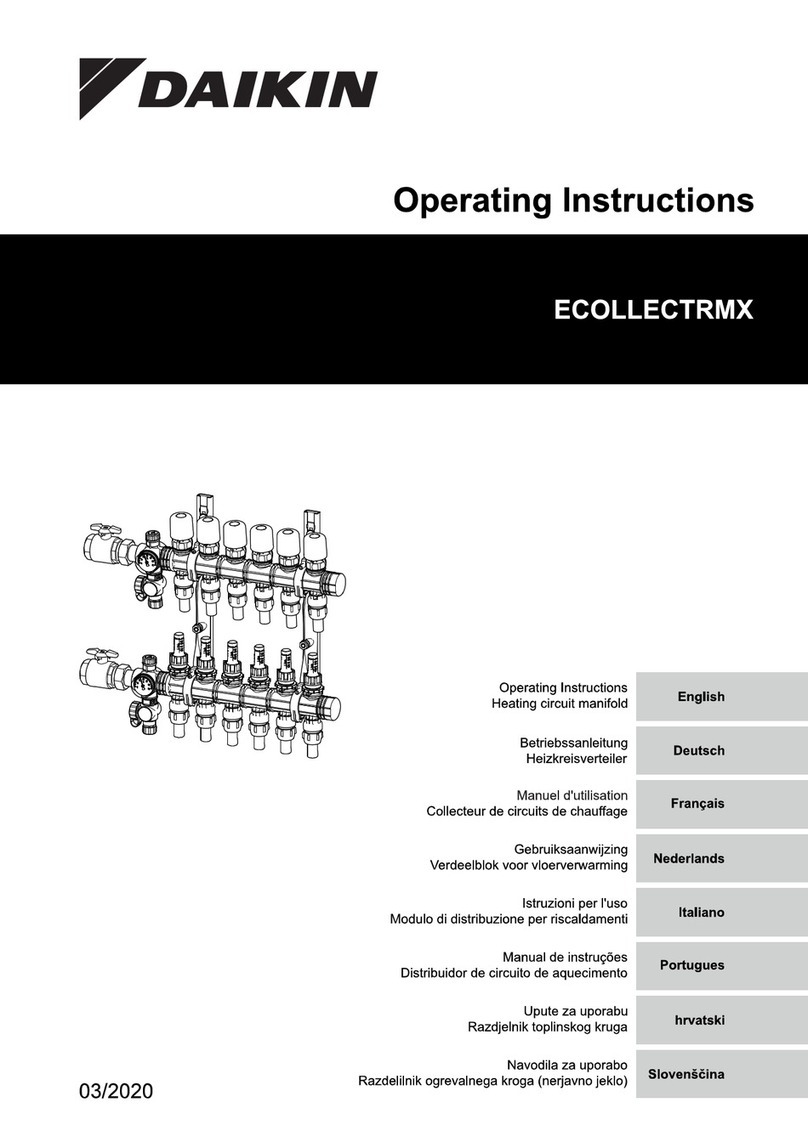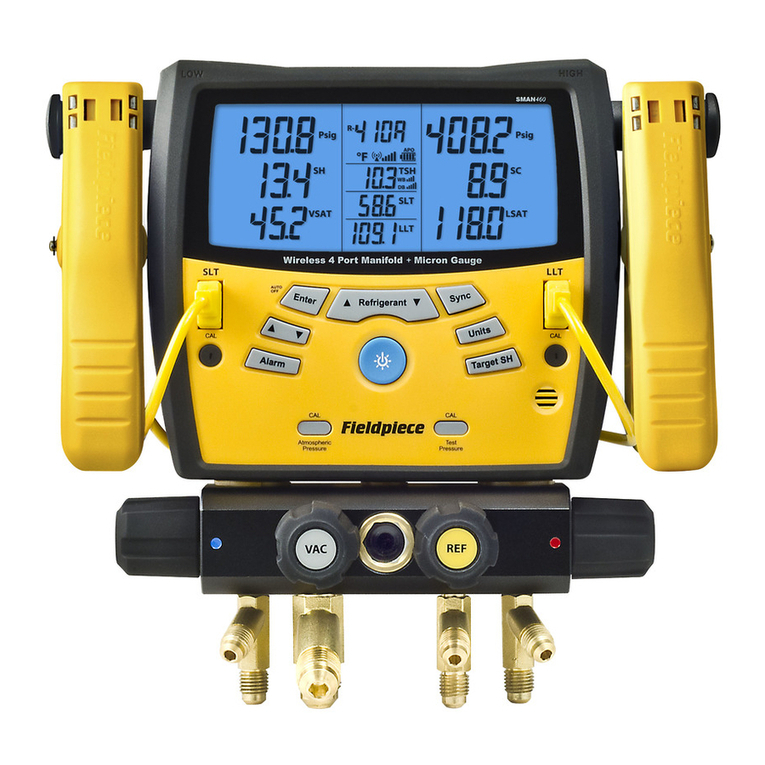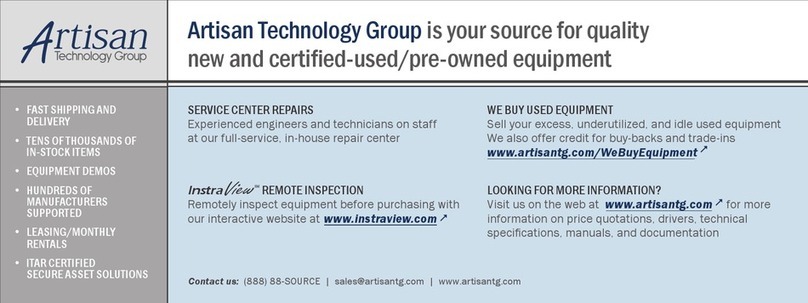Festo VTIA Series User manual

Description
VTIA pneumatics
Valve manifold
type VTIA−...
with valves
of type
VSVA−B−...−R...
and
type VSVA−B−...−C1
Description
538 929
en 1003a
[752 193]
Valve manifold VTIA


Contentsand general safety instructions
I
FestoP.BE−VTIA−EN en 1003a
Original de. ......................................
Editionen 1003a. .................................
DesignationP.BE−VTIA−EN...........................
Order no. 538 929. ................................
E (FestoAG&Co. KG, D73726 Esslingen, Federal Republic of Germany, 2010)
Internet:http://www.festo.com
E−mail:service_international@festo. com
The copying, distribution and utilisation of this document
as well as the communication of itscontentstootherswith−
out express authorization is prohibited.Offendersshall be
liable for damages. All rightsarereserved, in particular the
right tocarry out patent, registered design or ornamental
design registration.

Contentsand general safety instructions
II FestoP.BE−VTIA−EN en 1003a

Contentsand general safety instructions
III
FestoP.BE−VTIA−EN en 1003a
Contents
Intended use VII..........................................................
Target group VII..........................................................
Service VII...............................................................
Notes on the use of this descriptionVIII.......................................
Important user instructionsIX..............................................
1. Overview of components 1−1. . . . . . . . . . . . . . . . . . . . . . . . . . . . . . . . . . . . . . . .
1.1 The valvemanifold VTIA 1−4..........................................
1.1.1 Overview of variants1−4.....................................
1.1.2 Description of components1−5................................
2. Mounting 2−1. . . . . . . . . . . . . . . . . . . . . . . . . . . . . . . . . . . . . . . . . . . . . . . . . . . . .
2.1 General instructionson assembly and dismantling 2−4....................
2.2 Mounting variants2−5..............................................
2.2.1 Mounting/dismounting on an H−rail 2−6.........................
2.2.2 Mounting/dismantling from awall 2−9..........................
2.3 Mounting the inscription labels (optional)2−12...........................
3. Installation 3−1. . . . . . . . . . . . . . . . . . . . . . . . . . . . . . . . . . . . . . . . . . . . . . . . . . .
3.1 Compressed air preparation3−4......................................
3.1.1 Operation withunlubricatedcompressed air3−4.................
3.1.2 Operation withlubricated compressed air3−4....................
3.2 General notes on connecting the tubing 3−7.............................
3.2.1 Installing the tubing 3−7.....................................
3.3 Connecting the valvemanifold VTIA 3−10................................
3.3.1 Ducted exhaust of control air and venting air3−11.................
3.3.2 Pilot control (pilot air) 3−12....................................
3.3.3 Valvemanifold VTIA withpressurezoneseparation3−14............
3.3.4Reversibly operated valvemanifold VTIA 3−16....................
3.3.5 Operation of the valvemanifold VTIA withreversible
2x3/2−way valves 3−16.......................................

Contentsand general safety instructions
IV FestoP.BE−VTIA−EN en 1003a
3.3.6Operating the valvemanifold VTIA withreversible pressure
regulators3−17..............................................
3.3.7 Setting the pressureregulating valve3−17.......................
3.3.8 Vacuum/low pressureoperation3−20...........................
3.3.9 Connecting the pneumatic lines 3−20............................
3.3.10 Connecting the electric cables 3−25.............................
3.4Address assignment of the valves 3−31..................................
4. Comissioning 4−1. . . . . . . . . . . . . . . . . . . . . . . . . . . . . . . . . . . . . . . . . . . . . . . . . .
4.1 General Information 4−4.............................................
4.1.1 Prior tocommissioning 4−4...................................
4.1.2 Pressurebuild−up in the overall supply 4−4......................
4.2 Manual override(MO) 4−6...........................................
4.3 Checking the valves and the valve/actuator combination4−8...............
4.4LEDdisplay of the valves 4−11.........................................
4.5 Troubleshooting 4−13................................................
4.5.1 Impairment of functions4−13..................................
4.5.2 Operating states of the pneumatic system 4−14...................
5. Conversion and maintenance 5−1. . . . . . . . . . . . . . . . . . . . . . . . . . . . . . . . . . . . .
5.1 General preventiveaction5−4........................................
5.2 Dismantling the valvemanifold5−5....................................
5.3 Replacing valvemanifold components5−6..............................
5.3.1 Replacing valves or cover plates 5−6...........................
5.3.2 Replacing/adding componentsfor vertical stacking 5−7............
5.3.3 Replacing manifold sub−bases or end plates 5−11..................
5.4Conversion of the valvemanifold VTIA 5−15..............................
5.4.1 Conversion toducted pilot exhaust and venting air5−15............
5.4.2 Conversion of the valvemanifoldVTIA totwo or three
pressurezones 5−17.........................................
5.4.3 Adding valvepositions5−18...................................

Contentsand general safety instructions
V
FestoP.BE−VTIA−EN en 1003a
A. Technical Appendix A−1. . . . . . . . . . . . . . . . . . . . . . . . . . . . . . . . . . . . . . . . . . . . .
A.1 Technical dataA−3..................................................
A.2 Festoaccessories A−16...............................................
B. Supplementary overview of components B−1. . . . . . . . . . . . . . . . . . . . . . . . . . .
B.1 Overview of valveposition componentsB−3.............................
B.1.1 Valves withinternal pilot air supplyB−3.........................
B.1.2 Valves withexternal pilot air supplyB−6.........................
B.1.3 Vertical stacking componentsB−10..............................
C. Index C−1. . . . . . . . . . . . . . . . . . . . . . . . . . . . . . . . . . . . . . . . . . . . . . . . . . . . . . . . .

Contentsand general safety instructions
VI FestoP.BE−VTIA−EN en 1003a

Contentsand general safety instructions
VII
FestoP.BE−VTIA−EN en 1003a
Intended use
The valvemanifold VTIA described in this manual is intended
for fitting intoamachineor automated system. The user must
at all times observethe safety regulationsspecified in this
manual as well as the instructionsconcerning the intended
use of the relevant valvemanifold VTIA. The valvemanifolds
VTIA may only beused as follows:
As intended in an industrial environment
In original statuswithout unauthorised modifications.
Only the conversionsor modificationsdescribed in the
documentation supplied withthe product arepermitted.
In perfect technical condition.
When used together withconventional accessory compo
nents, suchas actuators, the specified limitsfor pressures,
temperatures, electrical data, torques etc.must beobserved.
The relevant national and local safety regulations(e.g.trade
association, German Technical Control Board (TÜV), VDE)
must also beobserved.
Target group
This manual is intended exclusively for technicianstrained in
control and automation technology.
Service
Please consult your local Festorepair serviceif you haveany
technical problems.

Contentsand general safety instructions
VIII FestoP.BE−VTIA−EN en 1003a
Notes on the use of this description
This description containsspecific information on mounting,
installing, commissioning, servicing and converting the valve
manifold VTIA. This manual describes only the pneumatic
componentsand referstothe valvemanifold variantslisted in
the table below.
Variants of the valve manifold VTIA
Valvemanifold VTIA withvalves withcommon
connectorstypeVSVA−B−...−R...
Valvemanifold VTIA withvalves withsquare
plugs(individual connection) typeVSVA−B−...−C1
Tab.0/1:Alternativeconnectionsof the valvemanifold VTIA

Contentsand general safety instructions
IX
FestoP.BE−VTIA−EN en 1003a
Important user instructions
Danger categories
This description containsinstructionson the possible dangers
whichcan occur if the product is not used correctly.These
instructionsaremarked (Warning, Caution, etc.), printed on a
shaded background and marked additionally withapicto
gram. Adistinction is madebetween the following danger
warnings:
Warning
... meansthat failuretoobservethis instruction may result
in seriouspersonal injury or material damage.
Caution
... meansthat failuretoobservethis instruction may result
in personal injury or material damage.
Note
... meansthat failuretoobservethis instruction may result
in material damage.
The following pictogram markspassages in the text which
describeactivities withelectrostatically sensitivedevices:
Electrostatically sensitivedevices: Incorrect handling can
result in damagetocomponents.

Contentsand general safety instructions
XFestoP.BE−VTIA−EN en 1003a
Identification of special information
The following pictograms designatetextsthat contain special
information.
Pictograms
Information:
Recommendations, tipsand references toother sources of
information
Accessories:
Information on necessary or usefulaccessories for the Festo
product.
Environment:
Information on environmentally friendly use of Festopro
ducts.
Text designations
·Bullet pointsindicateactivities that may becarried out in
any sequence.
1. Numerals denoteactivities whichmust becarried out in
the numerical order specified.
Arrowheadsindicategeneral activities.

Contentsand general safety instructions
XI
FestoP.BE−VTIA−EN en 1003a
The following product−specific terms and abbreviationsare
used in this manual:
Term/abbreviation Meaning
Blanking plate Cover for anon−assigned valveposition on the manifold sub−base.
Common connectorCentral electrical connection for valves typeVSVA−B−...−R... withM8or
M12 socket.
ComponentsUmbrella termfor manifold sub−base, intermediateplate, end plate,
vertical pressuresupply plate, pressureregulator plate, flow control
plate, valveor blanking plate.
End plate Right and left plateof the plateof the valvemanifold VTIA withpneu
matic supply portsand holes for wall mounting.
Intermediateplate Adapter platewhichcan beused tocombinesizes 18 mm and 26 mm
on the valvemanifold VTIA.
Manifold sub−base Platefor holding avalve, withworking lines 2and 4.
MO Manual override
Squareplug Individual electrical connection, squareplug toplug connection pat
tern DIN EN 175301−803, design Cfor valves withpneumatic interfa
ces toISO 15218 (typeVSVA−B−...−C1).
Tubing connections Connect the supply lines (tubing) tothe valvemanifold
Valve VSVA solenoid valve, as amonostable valve, bistable valveor mid−po
sition valve.
Valvemanifold VTIA Valvemanifold withpneu.port pattern toISO 15407−1, whichcan be
fitted withFestovalvetypes VSVA−B−...−R... and VSVA−B−...−C1.
Vertical pressureshut−off
plate
Platefor blocking the pressuresupply of avalveat the relevant valve
position.
Vertical pressuresupply
plate
Plateon avalveposition for individual compressed air supply
Tab.0/2:Product−specific terms and abbreviations

Contentsand general safety instructions
XII FestoP.BE−VTIA−EN en 1003a

Overview of components
1−1FestoP.BE−VTIA−EN en 1003a
Chapter 1

1. Overview of components
1−2FestoP.BE−VTIA−EN en 1003a
Contents
1. Overview of components 1−1. . . . . . . . . . . . . . . . . . . . . . . . . . . . . . . . . . . . . . . .
1.1 The valvemanifold VTIA 1−4..........................................
1.1.1 Overview of variants1−4.....................................
1.1.2 Description of components1−5
................................

1. Overview of components
1−3
FestoP.BE−VTIA−EN en 1003a
Contentsof this chapterThis chapter provides the following information on the valve
manifold VTIA:
The maximumnumber of valvepositions
The connection variantsand componentsof the valve
manifold
The labelling of the pneumatic components
Connection, display and operating elements

1. Overview of components
1−4 FestoP.BE−VTIA−EN en 1003a
1.1 The valve manifold VTIA
Festoassistsyou in solving your automation tasksat machine
level withvalvemanifold VTIA. The modular structureof the
valvemanifold enables you tomatchit optimally in your ma
chineor system.
The manifold sub−bases of the valvemanifold provides the
common ductsfor the supply and exhaust air.Working lines 2
and 4 areprovided for eachvalveposition on the individual
manifold sub−bases. The valves aresupplied withoperating
pressureand the valveexhaust air is dissipated via the com
mon ductsof the manifold sub−bases and the portsin the end
plates.
The pilot pressureis supplied via port 14 of the left end plate.
The function rangeat eachvalveposition can beextended by
meansof additional vertical stacking components, e.g.ex
haust air flow control or pressureregulation.
Depending on the manifold sub−bases used, the valvemani
fold VTIA is available with1, 2, 3... 16 valvepositions(see
also section 1.1.2 Description of components− Manifold sub−
bases).
1.1.1 Overview of variants
Sizes of the valvemanifold
VTIA
The valvemanifold is available in 18 mm and 26 mm sizes.
An intermediateplateis required tocombinethe two sizes
on onevalvemanifold.

1. Overview of components
1−5
FestoP.BE−VTIA−EN en 1003a
Electrical connection variants
Valvemanifold VTIA withvalves typeVSVA−B−...−R
withcommon connectors:
The valves areactuated via the common
connector on the valve.
These valves areavailable in the DC24 Vvoltage
variant.
Valvemanifold VTIA withvalves type
VSVA−B−...−C1 for squareplug as per
DINEN175301−803:
The valves areactuated individually at eachpilot
valve.
These valves areavailable in the voltagevariants
DC12 V, DC24 V, AC 24 V, AC 110 Vand AC 230 V.
Tab.1/1:Alternativeelectrical connectionsof the valvemanifold VTIA
1.1.2 Description of components
The valvemanifold VTIA consistsof the following pneumatic
components:

1. Overview of components
1−6 FestoP.BE−VTIA−EN en 1003a
123 4
5
6
8
7
91
2
9
3
3
1Right/left end plate
2Blanking platefor valveposition
(optional)
3Valves
4Intermediateplate(optional)
5Pressureregulator plate(optional)
6Flow control plate(optional)
7Vertical pressureshut−off plate
(optional)
8Vertical pressuresupply plate
(optional)
9Manifold sub−bases
Fig.1/1:Pneumatic componentsof the valvemanifold VTIA
Table of contents
Other Festo Digital Manifold manuals



